|
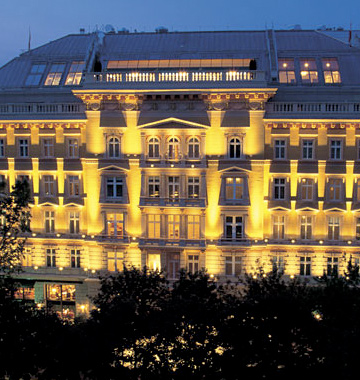 |
|
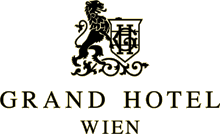 |
|
| Vienna - Austria |
|
 |
|
|
Extraordinary |
|
| September - 2003 |
|
5
Stars & 5 Stripes
Overall - 'Hotel & Service' |
|
 |
|
The Ultimate Award:
Seven Stars and Stripes® |
|
|
|
| Vienna, always known to be a genuine simmering pot of cultural
goulash, has for centuries catered to the needs of the Imperial cliques and
their circle of friends. It was not until 1870 that the Grand Hotel Wien opened
as the truly first luxury hotel in Vienna, and soon became the center for
catering to the extravagant needs of Viennese society and demanding
international clientele. |
|
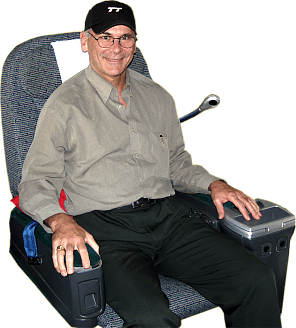 |
|
With
Vienna waltzing in my mind as my final destination, flying in from New York's
JFK airport with Austrian Airlines made it seem as if the Austrian experience
commences upon entering the modern, creative and comfortable Airbus. While
enjoying a flute of Schlumberger sparkling wine, I started to familiarize
myself with the onboard information system.
It was important for me
to be fully informed as to what to do and see while in the 'Heart of Europe'
and the flight attendants helped with some personal recommendations of their
own. They even let me know of a cute little 'Kaffehaus' on the Dorotheergasse
called 'Café Hawelka' where I must order the unique 'Powidltascherl' a
pastry pocket filled with sweet prune-butter. I made a mental note to go there
after I meet up with American Dream Team member Rolf once we finish our
upcoming reviews in the Imperial City. |
|
|
| While on-board, I eagerly began reading several articles about the
newly released VW entry into the luxury segment of the automobile market, 'The
Phaeton'. I couldn't help but wonder what it must be like to drive this awesome
vehicle through the byways of Imperial Vienna and I was not to be disappointed!
While still being pampered by the charming service of the Austrian flight crew,
German car maker Volkswagen was preparing to surprise us with their flagship
car 'The Phaeton' and as I landed, American Dream team member Thorsten was
already on his way with the fabulous machine. |
|
To experience the pulse
of a city you must venture into its very heart to mix with the locals, walk on
the same streets that countless millions have enjoyed for over 900 years and
find the best place to relax, the 'Kaffeehaus'.
The Grand Hotel Wien
is located at the Kärntner Ring, which is the footprint of the original
wall that once surrounded the city, the hub of action in Vienna, and the place
where one can be alone with one's thoughts while watching Vienna pass you by.
Imagine, here you are in the Grand Café, at the center of music, opera
and fine cuisine and yet you enjoy all this while feeling the flair in one of
the 'Leading Hotels of the World'. |
|
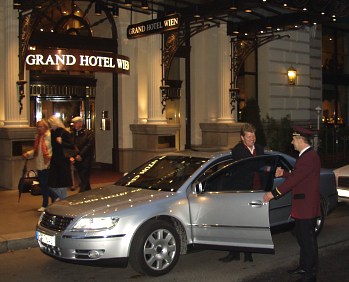
Arrival
with the Volkswagen Phaeton |
|
|
Friendly Austrians curiously turning heads to catch a glimpse of our
spectacular car that our partner Volkswagen has to offer -The Phaeton -heralded
our arrival at the Grand Hotel Wien. Our route to the hotel took us through the
Vienna Woods or "Wienerwald" and the elegant limousine provided us with total
traveling comfort over the gently rolling hills to our final destination,
defining an understatement of luxury.
The GPS navigation system led
us directly to the front entrance of Imperial elegance while negotiating the
numerous one-way streets with confidence and ease. The smartly dressed doorman
was the first to notice our team member Rolf opening the trunk to access the
luggage by simply touching the center of the VW emblem located there.
|
|
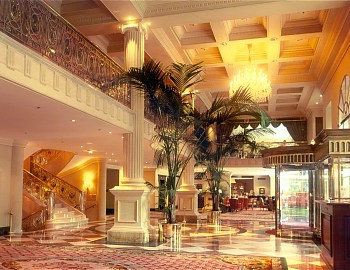 |
|
Upon arrival, the
check-in was smooth, professional and quick. We were able to glance around at
our new home for the next few days and noticed the incredible opulence of the
décor and layout of the main lobby.
It seemed to us that we
could spend an entire day just wandering around the Grand Hotel without really
seeing everything, so we arranged a guided
VIP
Tour with the Assistant Front Office Manager, Ingrid Gruber and together we
were able to discover the grandeur and elegance that the Grand Hotel Wien
displays so skillfully. |
|
|
Ingrid explained to us that the Grand Hotel preserves the unique
flair of the past by its use of exquisite fabrics and rare antiques while
offering the state of the art amenities to satisfy just about any need that a
guest can think of. Modern technology at your disposal, elegantly furnished to
meet every possible comfort requirement makes the Grand Hotel one of the most
modern and efficient luxury venues in the world.
This world-class
capability is essential in the business of guest satisfaction when you consider
that Vienna is host to the United Nations, the International Atomic Energy
Agency and OPEC (Organization of Petroleum Exporting Countries) from which is
generated many a discerning guest for meetings, conferences or just an
impressive place to stay. Impressive enough even for such diverse musicians as
Luciano Pavarotti, Paul McCartney and Johann Strauss (The king of Waltz) who
celebrated his 50 year jubilee on stage here in one of the ballrooms in
1894. |
|
Its ballrooms were the
scene of the most elegant parties in town and the uncounted "Bälle" of
Vienna are the most important platform to be part of society then and now.
Almost each profession established a Ball to celebrate once a year. Celebration
means food, wine and classic dancing - The Viennese Waltz -.
As the
most 'important' Ball the famous - Ball of the Opera - brings all the Austrian
and international celebrities together. Imagine how hard it is to get one of
those rare tickets, although proper planning and a professional concierge from
the Grand Hotel could make the difference. |
|
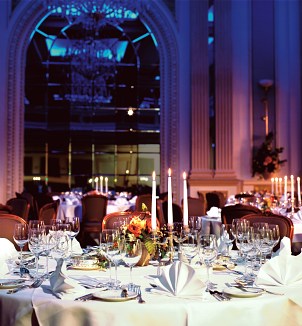 |
|
|
| No doubt it was now that we asked our hostess Ingrid to
see
the Presidential Suite. The Presidential Suite, measuring 220 square
meters, is the largest suite of the Grand Hotel Wien. Through a large ante-room
one comes directly into the living room and from there into the elegant dining
room and the adjacent library. On the other side there is a grand bedroom and a
very luxurious marbled bathroom with a whirlpool for the guest's
convenience. |
|

John Lomitola and Ingrid Gruber during the
VIP-Tour |
|
In addition there is a
kitchen where one's personal staff can prepare food and for guests wishing to
entertain in their suite there is a connecting door to a Junior Suite, which
gives the Presidential Suite two bedrooms and measures a total of 280 square
meters. "A great place to be!" commented Rolf.
But not everybody
enjoys the privileges of a presidential suite so we also visited one each of
the 25 double and 26 twin Exclusive Rooms. The walls and floors are decorated
in light green colors, which give the rooms a very relaxing
atmosphere. |
|
|
Our visit ended in the impressive hotel lobby where we met with Eva
Traunmüller, Communications & PR-Manager and Uta von Dietze Director
of Sales & Marketing for the Grand. While chatting with them at the
"Kavalierbar" overlooking the magnificent Ringstrasse, they informed us that
the Grand had been awarded "Austrian Hotel of the Year 2003" by a prestigious
German hotel and restaurant guide, which reflects our impression of a
successful transfer of tradition into the 21st century. We were also reminded
that since 2001, the Grand is a member of the "Leading Hotels of the World" of
which only the most distinguished properties are admitted and must meet the
most rigorous standards of excellence.
Rightly so we observed, after
returning to our suite and while we were changing to prepare for dinner at "Le
Ciel", it occurred to us that it was like being a guest at the Emperor Franz
Joseph's own palace. |
|
Our majestic Senior
Suite was equipped with the state-of-the-art telephone system from which one
can command practically the whole room from one's bedside. For example, the
television and radio can be turned on or off, as well as the lights. The
temperature may be individually chosen, and the 'Do Not Disturb' sign can be
turned on by just touching the screen of the telephone.
These
high-tech appointments can only be matched by the unwavering attention to
detail in the opulent décor of the room, which has been described as
"inspired by the flair of the monarchy and the music of Johann
Strauss". |
|
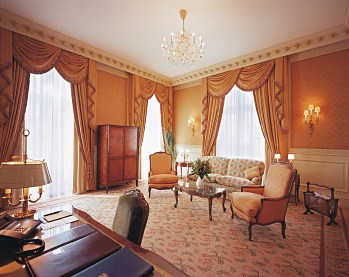 |
|
|
| To make things even better, a bellman attired almost as if he was the
Emperor's own servant, delivered a noble bottle of Sekt Bründlmayer Brut
2001 bearing the personal label of the Grand Hotel Wien, along with a deluxe
fruit basket stuffed with a box of 'Mozartkugeln'. Now that's class!
|
|
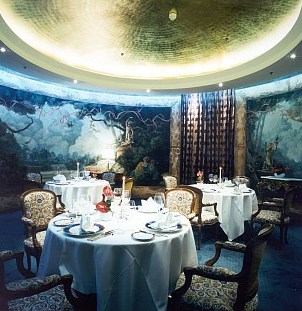 |
|
Le Ciel
Grand Hotel Vienna |
|
| Vienna - Austria |
|
 |
|
Extraordinary
September - 2003 |
|
5
Stars & 5 Stripes
Overall - 'Cuisine & Service' |
|
 |
|
The
Ultimate Award:
Seven Stars and
Stripes® |
|
|
|
| And now we must find the focal point for the entire Vienna Grand
experience, the place where enticing views of Vienna captivate the
unsuspecting, and culinary masterpieces are flawlessly prepared. Located on the
seventh floor of the Grand, we enter a world of magnificent wall art painted in
the style of the palaces of Schönbrunn, and we are led to our table in the
private "Rotonde" dining room. |
|
The initial impression
for Rolf and myself, went beyond our expectations in an instant as we were
seated and handed the creative menu of Executive Chef Siegfried Pucher.
While focusing on exclusive Viennese and traditional French specialties Chef
Pucher and his team, as we will see, skillfully apply a wealth of international
experience to their culinary art.
It was not long before we thought
how tempting it might be to forgo the written menu and allow Chef Pucher to
create something for us as far as his imagination would let him. Enough said,
our Maitre d' conveyed our request while both Rolf and I sat back and simply
waited and wondered what gustatory pleasure would most certainly come our way.
|
|
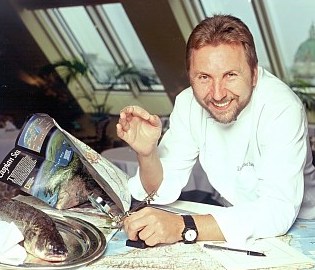
Siegfried
Pucher |
|
|
| In the meantime, Sommelier Franz Messeritsch prepared to compliment
each unique course with the appropriate wine selection, focusing primarily on
the marvelous abundance of local Austrian viniculture production. At the same
time as the creative juices were flowing in the kitchen, we couldn't help but
take in all the grandeur and comfort emanating from our surroundings while
listening to the waltz-like muffled voices of other satisfied patrons.
|
|
Chef Pucher began the
eventful evening by sending out a delicate seasonal specialty soup made from
locally grown produce. Creamy in texture, this fresh pumpkin with pumpkin
soufflé was drizzled with just the right amount of cold pressed pumpkin
seed oil thereby adding a toasted nutlike essence to this elegant dish.
Appropriately, a glass of 2001 Grüner Veltliner, Weingut Schloss
Gobelsburg, Kamptal was offered. It was vibrantly spicy with a penetrating grab
of fragrance and has an inner lightness that makes it float on your palate
rather than feel heavy. |
|
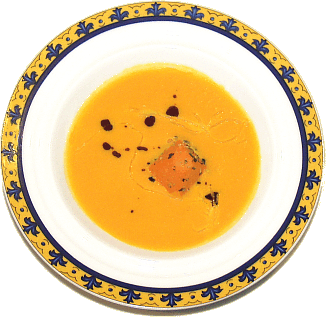 |
|
|
| For Rolf there now came a smoked venison carpaccio with Jerusalem
artichoke and fig salad. Paper-thin slices of garnet-red venison were carefully
positioned on the plate perfectly in concentric circles; their edges folded
gently to resemble little napkins. Scooping them up was like lifting miniature
bishops hats to your mouth. |
|
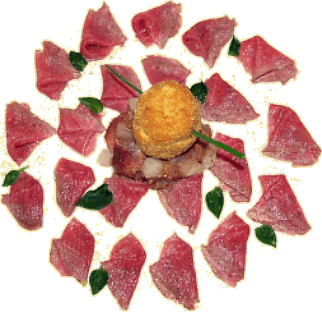 |
|
The accompanying
Jerusalem artichoke and fig salad perfectly complimented the venison by
offering the sweet taste and floral fruit of the fresh figs with the added
texture similar to water chestnuts.
The accompanying glass of 2001
Blauer Burgunder (Pinot Noir) Weingut Heinrich, Neusiedlersee performed
flawlessly as it offered up a full-bodied, barrel aged red wine with wild berry
fragrances although dry in the finish. |
|
|
Next came a delectable serving of marinated turbot (the king of all
fish) with Brussels sprouts and apple salad. This was our heaven and we must
have shown it with a certain look of satisfaction while savoring the subtle
contrasts of the combined ingredients.
Certainly a nice pinot gris or
sauvignon blanc would go well with this course and we could see Sommelier
Messeritsch approaching with a well chilled glass of 2002 sauvignon blanc,
Weingut Erwin Sabathi, Gamlitz Sudsteiermark. A fine selection since January
2004, 'THE BEVERAGE TESTING INSTITUTE' of CHICAGO tasting rated it exceptional
at 91 points. |
|
Now the real test; how
the Austrian Chef will handle an American icon, the Black Angus Beef
Tenderloin. An extremely tender cut of meat that when cooked properly can offer
up a mouth watering, juicy tid-bit with each fork full.
Chef Pucher
deftly prepared the meat with accompanying cream potatoes and oven roasted
vegetables surrounded with a surreal red wine demi-glace. The sauce had a deep
rich hand crafted flavor and was immediately in tune with the delicacy and
tenderness of the meat. Rolf was now in his own personal heaven! |
|
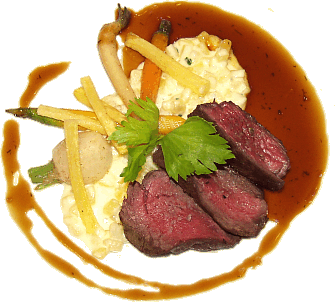 |
|
|
Of course, it is now apparent that we must be in line for the next
attempt to duplicate this culinary wizardry! Once Rolf is deeply involved with
his Angus, a platter of whole pan-fried sole with root vegetable ragout, leaf
spinach and truffle sauce arrives. My initial attempt to sample the sauce does
nothing more than intoxicate me with the earthy undertones of the grated
truffles. I wanted more and began to de-bone the sole when the maitre d'
reduced the endeavor to a cake-walk with two or three strokes of his fish
knife. I savored every morsel of fish while continuously going back to the
truffle sauce to feed my addiction.
This time a 2001 Grüner
Veltliner Smaragd, Weingut Prager, Weissenkirchen, Wachau (more on this
fabulous vineyard later) was the appropriate selection. It produces full, dry
and concentrated fruit, rich and simple with a lovely follow through.
|
|
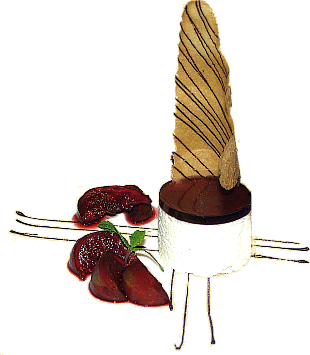 |
|
It is now nearly
impossible to describe the level of satisfaction written all over our faces. A
brief respite was in order and what awaited us at this point was the 'grand
finale' so to speak, but we could barely move.
For me, it had to be a
café Mélange to collaborate with the sweet cheese mousse with
cassis jelly and marinated figs. It came to the table suggesting a crisp tower
of sweet wafer atop a foundation of 'Topfen' resembling the texture of
cheesecake. Needless to say, an appropriate dessert wine of 1999
trockenbeerenauslese, Weingut Angerhof, Tschida, Illmitz was in order now and
it produced a light yellow-gold color with green reflections and a gradual
background aroma of citrus peels. |
|
|
| In front of Rolf was now placed a deep-fried chocolate praline on
exotic fruits with vanilla parfait. You could tell this was going to be
something special with the unusual combinations of textures and colors and it
certainly was. At first bite you sense a cornucopia of flavors blissfully
connected with crisp baked fillo dough and fluid crème Anglese just
begging to be polished from the plate. |
|
While almost whimpering
for help Rolf began to savor his dessert, then the sommelier brought the
corresponding wine paring to the table, it has been a long evening.
This time it was the Bründlmayer Grand Hotel Cuvee Speciale Brut, the
specially labled sparkling wine available only at the Grand Hotel Wien.
|
|
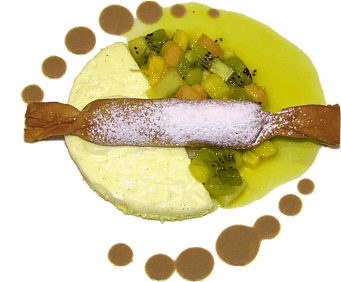 |
|
|
It always amazes us when cultures meet to share the fruits of their
tradition, especially under the watchful eyes of Le Ciel's Executive Chef
Siegfried Pucher and his capable and dedicated team.
Inspired by rich
Viennese traditional food, and in desperate need of a long walk, we settled on
going through the old heart of Vienna on a city tour: |
|
A walk through the historic city
center
Excited to explore the heart of the city we left the
calm and noble atmosphere of the Grand for a walk around the block to the
Kärntner Strasse, a pedestrian oasis in a city buzzing with activity.
Without a guide the city center is organized and regal and it surprises you
with so many famous historical sites that it is easy to forget time.
The Hofburg
We decided to start with the Hofburg, which was
originally a medieval castle, but today only the castle chapel remains of its
medieval past. The Hofburg was extended to a magnificent residence when the
Habsburg's power increased. |
|
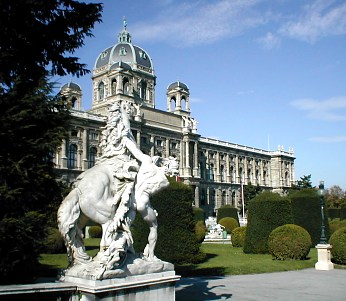 |
|
That is the reason why
one can uncover almost any architectural style, from gothic to art nouveau.
Nowadays this enormous complex is the home of the "Österreichische
Nationalbibliothek" (National Library), the "Schatzkammer" (Imperial Treasury),
the Collection of Musical Instruments, the Collection of Weapons, the "Museum
für Völkerkunde" (Museum of Ethnography) and the famous "Spanische
Hofreitschule" (Spanish Riding School) home of the world famous Lipizzaner
horses. |
|
|
The Spanish Riding School
The Spanish Riding School
is the oldest and last riding school in the world where classic dressage is
still practiced in its purest form. This Institute was founded in 1572 and its
name was derived from the fact that the horses were of Spanish
origin. |
|
The Lipizzaner is
regarded as the oldest classic horse race in Europe and the riders of the
Spanish Riding School train their horses and perform in the Winter Riding
School in the Vienna Hofburg (Imperial Palace) in a splendid Baroque structure
hall built by Josef Emanuel Fischer von Erlach between 1729 and 1735.
The presentations of classical dressage have been open to the public since
1920. |
|
 |
|
|
The Vienna Opera House
Linking history with today's
world class entertainment we walked back to the Ringstrasse where the old
Vienna Opera House (Oper) is playing the classics of opera pieces in
contemporary style. |
|
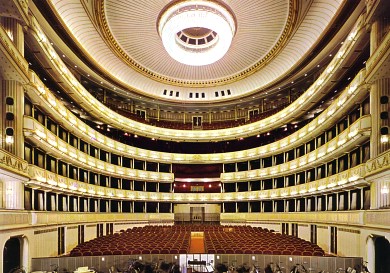 |
|
August von Sicardsburg
and Eduard van der Nüll built the Court Opera House from 1861 to 1869.
The Vienna Opera House has a world-wide reputation for its first-class
opera performances and is also known for the Vienna Philharmonic Orchestra. A
night at the State Opera is one of the most impressive events any visitor to
Vienna can experience. |
|
|
| We recommend taking a guided tour through the building before the
evening shows start. The classic interior of the Opera is remarkable and kept
in very good shape and this is a place to impress your partner and
friends! |
|
Riesenrad - Ferris Wheel
Another one of Vienna's
treasures, the giant Ferris wheel is a leftover from more genteel times, much
like the city itself. This wheel was one of a handful built around the world.
Three were built in Europe, one in England, a second in France, and the third
in Vienna. The English and French wheels have since been dismantled. Another
one was erected at Navy Pier in Chicago. |
|
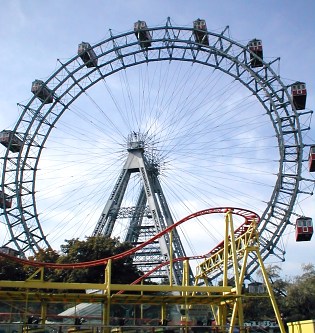 |
|
At 200 feet, these
wheels are much larger than the ones in most of today's amusement parks. Each
capsule can hold dozens of people as the wheel turns at just 2.5 feet per
second. The goal here is to elegantly thrill audiences with the view, not scare
them to death. To that end, some of the capsules are formally decorated and can
be rented for weddings, dinners, and other occasions.
This is
appropriate because the Prater, the park where the Ferris wheel is located, was
once the exclusive domain of the emperor. The island in the Danube was his
personal hunting ground until 1766 when Joseph II opened it to the public. Some
of the children's rides have been in service since the 1920's. But the Ferris
wheel, built in 1896, is the oldest of all. |
|
|
| The amusement park is more popular at night than during the day when
the lights and sounds from the rides and games seem more vivid. The Ferris
wheel was featured in Graham Greene's 1949 classic film "The Third Man." It was
again used in the 1987 James Bond flick "The Living Daylights." Though this
mode of transportation may seem quaint to the untrained, it is considered a
"proper" means of recreation, and may even be making a comeback. |
|
Champagne - Made in
Austria
After this first glimpse into the rich history of
the capital of Austria we were keen to explore another diamond of Viennese
lifestyle - The Schlumberger Winery. While we had our first opportunity to
taste the Cuveé Klimt in the City Tavern in Philadelphia we were keen to
follow the Schlumberger history with its unique roots to Reims in France the
heart of the Champagne. |
|
Schlumberger Extra Brut
1996 Vintagehas receives |
|
| Austria |
|
 |
|
Extraordinary
September - 2003 |
|
| 5
Stars & 5 Stripes |
|
 |
|
The
Ultimate Award:
Seven Stars and
Stripes® |
|
|
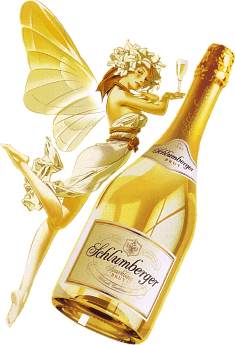 |
|
|
| Near to the city center on Heiligenstädter
Straße 43 not far from the beautiful blue Danube River, we had been
invited by winery manager Peter Höller to discover the cellars and sample
the fine products of the Schlumberger Sektkellerei. We were told that the
founder Robert Schlumberger, an Aristocrat from Goldeck, began his career in
Reims (France) at the oldest Champagne Cellar Ruinart Père et Fils.
After returning to Vienna and grounding Schlumberger in 1842, he started to
produce sparkling wine according to the traditional ‘Méthode
Champenoise’, the knowledge of which he had acquired while in France. "A
row of experiments using Austrian wine brought us to realize that it would be
possible to produce sparkling wine in such a manner that it could truly compete
with Champagne.” (Robert Schlumberger) |
|
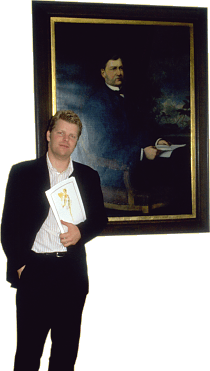 |
|
The special selection of
Austrian wines and the use of the “Méthode Traditionnelle”
guarantees a high level of agreeability. At Schlumberger, close attention is
paid to ensuring the highest quality. Beginning already with the careful
selection of the grapes, the comprehensive quality management system has led
Schlumberger to be the first certified Sparkling winery (ISO 9002) in the
German-speaking world. Since 1994, Schlumberger has been able to boast this
accomplishment.
During our well-presented tour through the Wine
Cellar, which allows you to walk for several miles under the city of Vienna; we
were deeply impressed by the effort behind the production of the top of
Austrian Sparkling Wines.
The making of the Cuvée, or blending
(French-Assemblage), of the various wines and vintages requires much experience
from the vintners and the oenologists. |
|
|
The goal is, of course, to ensure Schlumberger a high
standard of quality and achieve the unique individual taste that the consumer
recognizes by blending exactly the right amounts of the wine varieties. By
fortifying the Cuvée with liqueur de ‘tirage’ and selected
yeasts, for which Schlumberger has a patent to use, the wine goes through a
second fermentation. The selected yeast causes important side effects during
the aging process and positively influences the aroma.
The
Cuvées are now filled into the bottles and the second fermentation
begins, in which the yeast and sugar eventually change to alcohol and carbon
dioxide. |
|
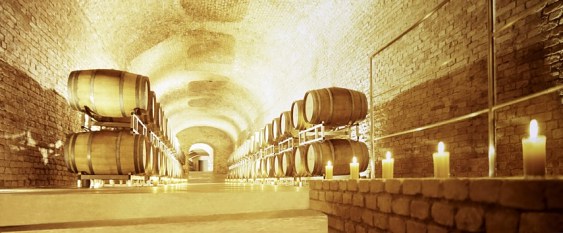 |
|
| The bottles are then stored in the kilometer-long
vaults at a constant temperature of 11° Celsius for at least 18 months. The
Cuvée matures and the Schlumberger achieves the unmistakeable bouquet
and mousseux. |
|
Once the
shaking is completed, the yeast settles on the cork. The sparkling wine is now
crystal clear and pure. From now on, the bottles will be stored upside-down.
The sparkling wine is now on its way to being completed.
The bottles
are racked, meaning that they are taken from the riddling area and stored
closely together upside-down.
They will remain this way until it is time
for the next step. |
|
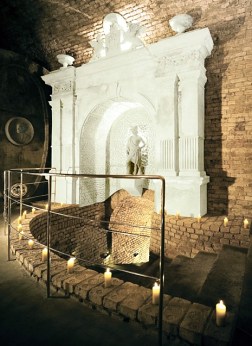 |
|
There is punt on the bottom of the bottle, which is an indentation
that helps keep the cork in the bottle.
The next step, after the
fermentation in the bottle, shaking, and racking, is the step of
disgorging.
This is a process only used in the “Méthode
Traditionnelle”.
The neck of the bottle is placed upside-down into an
ice bath for several minutes until the yeast sediment (lees) clumps. Utilizing
the pressure of the sparkling wine, the lees is spun out of the bottle.
|
|
|
| The clear wine begins to foam, as perhaps expected,
but not out of the bottle, since the carbon-dioxide is molecularly bound due to
the low temperature. The sparkling wine is freed of the lees particles and it
now crystal clear. |
|
Within the 24 days of
bottle fermentation the "Kellermeister" manually has to turn 30.000 - 40.000
bottles each day.
Each bottle has a little white mark on its bottom,
which indicates the progress of the turning process inch by inch. |
|
 |
|
|
| After the disgorging process, dosage liqueur is added
to the sparkling wine. This determines the sweetness (e.g. dry, semi-dry) of
the Schlumberger. The dosage consists of wine and sugar. The level of sugar
determines the taste. Dry sparkling (Extra Brut) contains no dosage. The exact
composition of the dosage is a well-kept secret of Schlumberger. |
|
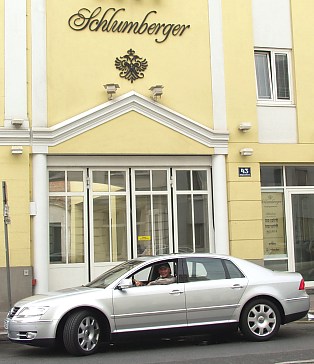 |
|
The Schlumberger Wine
Selection:
Schlumberger
Sparkling Brut
Grape variety: Welschriesling
Schlumberger Extra
Brut 1996 Vintage
Grape variety: Welschriesling
Schlumberger
Sparkling Brut 1998 Vintage
Grape variety: Welschriesling
Schlumberger Chardonnay 1998 Vintage
Grape Variety: Chardonnay
Schlumberger Blanc de Noirs
Grape Variety: Blauer Burgunder (Pinot
Noir)
Schlumberger Cuvée Klimt
Grape variety:
Welschriesling
Schlumberger Rosé 1998 Vintage
Grape
variety: Blauer Burgunder |
|
|
| We are convinced that a process this unique, which
produces a wine of such a high caliber, will announce its presence to the world
in a fashion consistent with the greatest champagnes now on the market.
Schlumberger is reaching for the stars, one bottle at a time! |
|
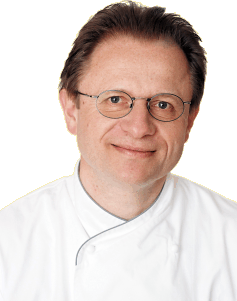 |
|
| Helmut Oesterreicher |
|
|
| The Steirereck |
|
| Vienna - Austria |
|
 |
|
Society
September - 2003 |
|
6
Stars & 6 Stripes
Overall - 'Cuisine & Service' |
|
 |
|
The
Ultimate Award:
Seven Stars and
Stripes® |
|
|
|
The American Dream Magazine Team is proud to present
the Steirereck Restaurant with 6 Stars and Stripes for outstanding world-class,
innovative cuisine and superb, ultra-professional and conscientious service.
Hats off to Family Reitbauer and Executive Chef Helmut Österreicher and
his capable staff:
The Steirereck: Steirereck Bienvenue at
Austria´s leading cuisine:
As the well-dressed head valet
from the Grand Hotel Wien hailed a cab for us, I was still busy fumbling
through my Knopf City Guide for Vienna to see if I could determine the exact
location of the Steirereck Restaurant, represented by Relais & Chateaux as
one of the finest restaurants in Europe. Rolf and I decided that apart from
being a compulsive map freak, our efforts would be for nothing since every
cabby in Vienna must know precisely where this superb, elegant eatery is
located. |
|
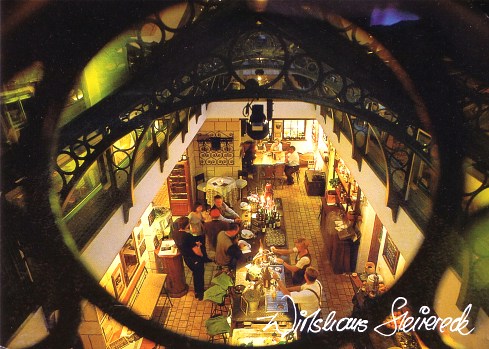 |
|
| ‘Ja freilich’ was the cabby’s response
when given the name of the restaurant and this just confirmed our private
theory. The restaurant is located on the Rasumofskygasse, 3rd district just a
few minutes from the inner ring center of Vienna. |
|
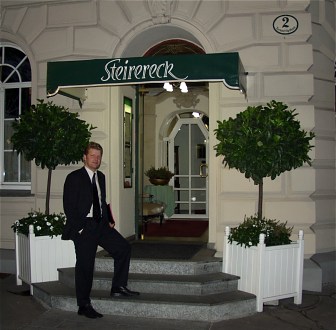 |
|
The atmosphere began as
we stepped out of the cab and headed toward the door past rows of mature
chestnut trees being stirred by an east wind probably originating somewhere out
there on the vast Hungarian plain not far from here. |
|
|
| History has made Vienna a veritable melting pot of
cultures and traditions, as we were about to experience as we entered the
establishment through dimly lit portals. |
|
 |
|
| A quick glance to our left through an elegant atrium
grudgingly revealed the most serene vision of well dressed Viennese locals
happily dining and conversing with one another, a favorite pastime of
residents. |
|
| Our
reservation was quickly noted and we were seamlessly escorted to our table past
the same happy campers we saw from the outside, oblivious to our entrance and
quite content to enjoy each others’ clandestine conversations, as if a
scene were lifted out of the movie ‘The Third Man’, the classic spy
thriller about Vienna after WW II. |
|
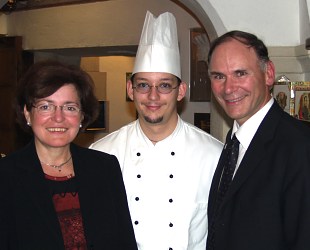
Frau Reitbauer and John Lomitola
accompanied by the Chef de Cuisine |
|
Upon being
seated, we were greeted promptly and introduced to the owner Frau Reitbauer who
graciously welcomed us and began laying the groundwork of what was to become a
memorable evening. As she made her way around to all the other
guests, |
|
|
| Rolf and I started to realize that every interaction
by all members of the staff contribute to the total experience of every guest's
satisfaction. |
|
| As we were perusing the
extensive menu, which emphasized the diverse cultural influences of Vienna's
imperial past, we were greeted by two lovely, impeccably dressed servers with
impish smiles pushing a garadon piled high with every kind freshly baked bread
one could imagine. |
|
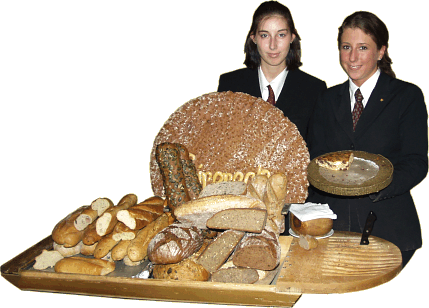 |
|
|
| Our appetite began to develop with every mention of
the next special bread to be combined with fresh cream butter or pumpkin seed
oil, a regional specialty for the season. Rolf and I were still pondering the
bread choices, seemingly overwhelmed by the anticipation of so many flavors
about to assault our senses, when the sommelier arrived with the first of the
all-Austria wine selection to be served with each of our courses. |
|
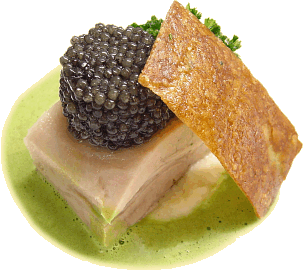 |
|
My course of consume
with semolina dumpling topped with caviar, was accompanied by 2002 Zieregg
Müller, (Cabernet Sauvignon blanc, Muskateller & Riesling) while
Rolf's goose liver pate coated fresh fig, was paired with a 2002 Welschriesling
Spätlese lieblich, Feiler - Artinger (Rust, Burgenland). |
|
|
Next came the delicate
flavors and aromas of fried yellow boletus (chanterelle mushrooms) sliced very
thin and arranged in a spiral, together with 2001 Weissburgunder
Jägerberg, Sabathi (Südsteiermark).
Not to forget the rock
lobster tail served over steamed chicory, served with 2000 Weissburgunder
“Kranachberg”, (Sattlerhof, Gamlitz). We must say that at this point
we were wondering how it was possible to improve upon this imaginative bucolic
and earthy presentation, which again reminded us of what it must have been like
dining with the aristocracy during the Imperial days. |
|
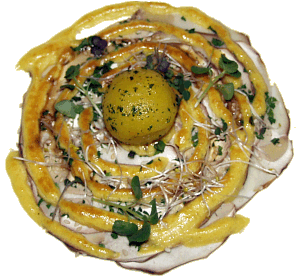 |
|
|
|
A small interlude was in order now as an
opportunity to savor the incredible tastes of what was being woven for us by
such capable hands. One of the adorable little bread girl returned to our table
offering further gifts of 'brot' when we noticed a small lapel pin that she was
discretely wearing. Upon asking, she informed us that it was symbolic of her
qualification as a sommelier, which of course made us applaud the incredible
depth of knowledge reserve as a further indication of 'World-Class' service to
go along with the cuisine in the Steirereck. |
|
| Our next courses began
to arrive with anglerfish coated with fresh crisp breadcrumbs and served over a
light tomato broth with octopus, joined by a 2000 Sauvignon Blanc smaragd,
(F.X. Pichler, Wachau) from the banks of the Danube. Rolf received the saddle
of venison with traditional red cabbage, together with a 2000 Domovina, Konrad
Mariel, (Wulkaprodersdorf). |
|
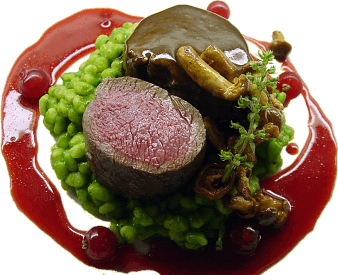 |
|
|
It is now time to reflect on just why it is that Executive Chef
Helmut Österreicher was voted the best chef of the decade in all of
Austria, by Gault Millau, the foremost gourmet guide in Europe. The rating
bestowed upon the Steirereck of 19 chef’s hats out of a possible 20
classified it as one of the world’s best, and the dinning experience so
far has held this to be true.
While our senses were running wild and
our imagination unabated as to the next course, we paused to ask if we could
possibly meet the man behind all these incredible visual and gustatory
creations for the palate. |
|
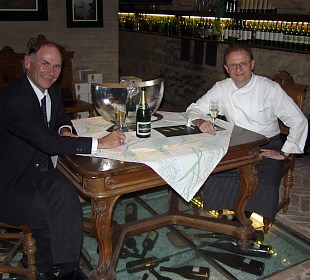
John Lomitola and Helmut Oesterreicher
|
|
Instead of entering the
kitchen as expected, Rolf and I were led to a narrow stairway leading down to
what seemed like a dungeon. The lower we went, the cooler it got until we
arrived at the bottom where we were met by the sight of Executive Chef Helmut
Österreicher sitting at a table in the middle of the room with a bottle of
Canard-Duchene Brut champagne on ice surrounded by several glasses.
Here we were, face to face with the country’s best chef deep in the bowels
of the Steirereck’s world-class wine cellar. |
|
|
| Chef Österreicher’s philosophy is simple and
straightforward, to give every guest the very best by sight, smell and taste
while using the freshest of ingredients in an uncomplicated way. |
|
Little did we know that
upon our arrival back to our table, we were about to be surprised by one of the
most creative innovations which we have yet to see used in a restaurant. One of
our cute little impish bread girls was now standing in front of a gara don
loaded to the top with fresh live herbs of every color and scent.
As
we were being instructed as to the difference between the herbs we began to
make choices that would result in the finest, freshest pot of tea we have ever
experienced. |
|
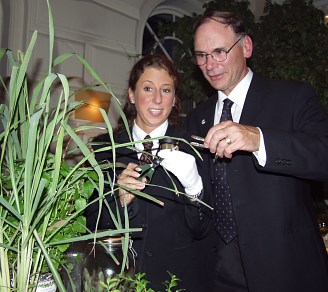 |
|
|
|
Immediately following the herb cart came an assortment of Austrian cheeses that
would have been a feast on its own without the rest of the dinner if we had had
the choice in the beginning. |
|
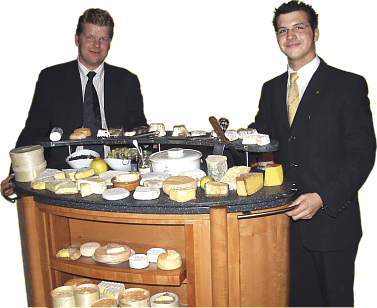 |
|
Cheeses from Austria
are some of the finest and are virtually unknown outside of the country. Milk
used in the processing of these cheeses still arrives fresh and unpasturized to
the small boutique style cheesemakers doors, and is minimally processed before
being released for sale.
The fact is that these cheese selections
were by far the most flavorful and fresh tasting we have ever experienced, and
we were encouraged to drizzle some Styrian pumpkin seed oil on the plate to use
as a compliment to the cheeses. |
|
|
| American Dream Tip: Take a few bottles of this fine product
home with you to give as gifts! |
|
| What could possibly top
this already delectable and innovative assault on the senses? We were well
prepared for the final event as we sipped our Viennese coffee specialties, a
'Grosse Brauner' and a 'Mélange'. As we were presented with a
chocolate-soufflé with chestnuts and rowanberries together with a glass
of 2000 Port vintage, (Burmester), it became apparent that we had just finished
perhaps one of the greatest culinary experiences to which we had ever been
exposed. |
|
 |
|
|
An excursion to the Wachau
It seemed highly unlikely
that we could just sit still and take in all the fabulous culture and luxury of
our unique surroundings in Vienna without at least one excursion somewhere
outside the city limits. To start with Rolf and I challenged the concierge at
the Grand Hotel Wien to map out a special tour for us so that we could see what
there is out there 'am land' and at the same time put the VW Phaeton through
the paces and have some fun. Without hesitation the concierge mapped out a
self-driving tour for us, pointed west and said "Wachau"!
It seems
that the 'Wachau' has been cited by UNESCO as a World Heritage Site which means
that it is an area in which material evidence of its long historical evolution
has survived to a remarkable degree. We weren't even half way out of the lobby
when Rolf told the bell captain to 'crank-up the car' and get going! We hadn't
even so much as packed a lunch and in minutes we were cruising west along the
beautiful Danube towards as yet an unknown ultimate destination. |
|
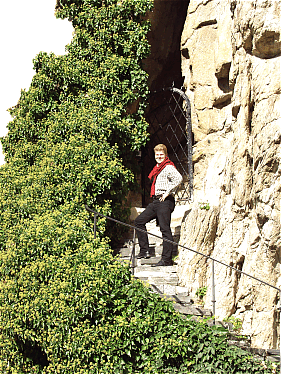 |
|
The road west out of the
city passes through a narrow gorge near the picturesque areas of Grinzing,
Kahlenberg and Leopoldsberg where it is said that in 1529 the defenders of
Vienna were able to hold off the siege of the Turks under Suleiman the
Magnificent. In the Turkish camps after the battle, they found bags filled with
coffee beans - their first appearance in Europe -, which were used by the Turks
as a stimulant, alcohol being forbidden.
The stuff caught on, and
coffee was soon a European sensation. By now my mind was spinning with the
strongest desire to stop at the first place to have a Café
Mélange, but I put my head back down in my Michelin road map and played
the part of Tonto leading the Lone Ranger Rolf out of an ambush. |
|
|
| Once safely past the invading armies, the landscape changed to a low
flat floodplain and on the map we noticed we must pass the town of Zeiselmauer.
It intrigued us to think that around 900 years ago, the Roman's set up a
military camp and settlement here of which there has been found the remains of
wall fortifications. Could it be that the Romans also saw this location as a
good forward base to alert and defend the main camp of Vindobona, now Vienna,
just to the east? |
|
We looked out of
the smooth sailing Phaeton to see if the ruins are visible and notice acres and
acres of vineyards. The wall must be buried somewhere in the midst of all those
grapes and then it occurs to Rolf that the vineyards began while we were still
in the Vienna city limits and have continued in profusion. Scholars have it
that grape growing in this area began with the Celts a few centuries BC.
I guess the Romans needed a little diversion to handle the loneliness of
their outpost, and we read that Vienna today is the only city with over a
million inhabitants that has considerable wine production (approx. 700
acre). |
|
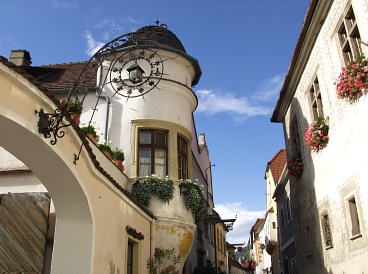 |
|
|
We crossed the peaceful meandering Danube at Krems and entered
the ethereal region of the 'Wachau', which is now part of Austria and full of
history and folklore. Crusaders and pilgrims of the High Middle Ages as well as
merchants and travelers have used the second largest river of Europe, the
Danube, extensively and we could now see modern pilgrims using the waterway for
sightseeing on one of the many riverboats competing for business.
This is a place where some of the best attractions are free, or nearly so. A
stroll along the paved pathway through the vineyards of the Wachau Valley costs
nothing and you can use the money you save to splurge on a slice of Sachertorte
in Vienna. |
|
Our modern day chariot
glided around each bend of this fabulously beautiful enclave and suddenly we
see the village of Dürnstein up ahead perched on the side of mountain, the
sheer cliffs of which cascade straight down to the Danube.
As we
entered the town I see no reason to go any further and seize the moment to
convince Rolf to pull off the road to explore. Hundreds of people have been
smitten with the same notion and the village is an ocean of peaceful strollers
in dappled sunlight. Heads turn curiously as we parked the Phaeton and prepared
to enter the fray. Our goal seemed to be to find the best location from which
to photograph the rhythmic cruising taking place on the river.
|
|
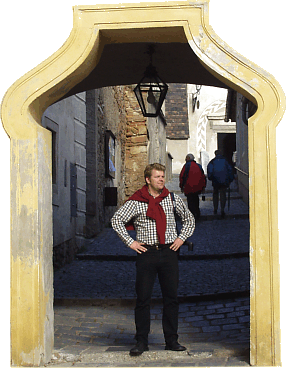 |
|
|
| Dürnstein is a village where history comes alive in the small
lanes of the old-town, the monastery and the castle ruin above the town. The
capture of King Richard I (Lionhearted) in 1192 attracted attention throughout
Europe. It is said that when King Richard returned from the crusades, the
Austrian duke Leopold V decided that because of an insult Richard should spend
several months imprisoned in Kuenringer castle until a hefty ransom was
paid. |
|
|
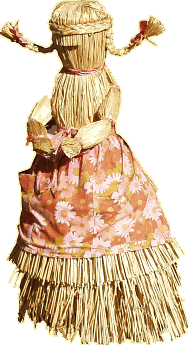 |
|
A much smaller
ransom was needed to purchase souvenirs in the quaint shops that lined the
narrow cobblestone streets. I couldn't help but remind Rolf that souvenirs
aside, we still needed to find a place to have our favorite Café
Mélange so we wandered under a beautiful archway into Schloss
Dürnstein, a picture perfect castle built in 1630.
It was like
stepping into the 'Twilight Zone' and Rolf realized that a simple costume
change was all that was needed to put the icing on the cake. We could imagine a
contemporary Brothers Grimm being inspired enough to use this Schloss as a
backdrop while directing a 'Lord of the Rings'-type sequel. |
|
|
| Frau Thiery the hospitable proprietor now asked if we would like a
tour of the hotel, and our interest peaked as we walked through the lobby and
up the grand staircase to the upper levels. |
|
The rooms are palatial
in size and décor and appropriate enough for the Emperor Franz Joseph
himself although we don't think he could have handled some of the modern
technical amenities without a lot of coaching.
The overall
architecture of the Schloss is in the Renaissance style, precious antiques
decorate most of the rooms, and it accurately radiates an atmosphere of refined
elegance in its purest form. |
|
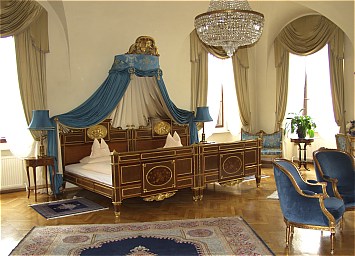 |
|
|
| We were about to bid farewell to our charming host, when her
distinguished face lit up and she suddenly made a phone call chatting
enthusiastically while motioning us to sit back down on the patio. |
|
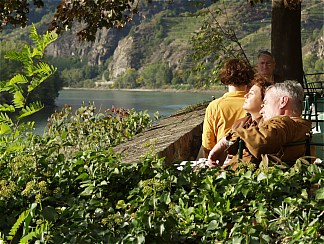 |
|
In a matter of minutes
two gentlemen arrived and we discovered that she had arranged for us to be
escorted by her son and the winemaker Anton Robert Bodenstein for a private
tour of the nearby Prager Vineyards.
What a pleasure it was to have
met such a wonderfully accommodating person such as Frau Rosemarie Thiery.
|
|
|
The Wines of the Prager
Vineyard
Inspired by the rich nature of the Wachau and the
fortunate spontaneity of our gracious host at Schloss Durnstein, we decided
take a break on our inspiring journey through the Wachau with a privileged
visit to one of the leading wine producers in Austria, the Prager Vineyard and
Winery. |
|
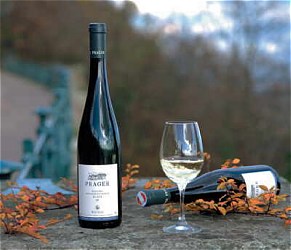 |
|
|
The Prager Winery |
|
| Austria |
|
 |
|
Extraordinary
September - 2003 |
|
| 5
Stars & 5 Stripes |
|
 |
|
The
Ultimate Award:
Seven Stars and
Stripes® |
|
|
|
| Anton 'Toni' Bodenstein, the congenial winemaker welcomed us to the
premises of the vineyard and the old country house above the river Danube. The
estate is a warren of terraced beauty from which the verietal makeup is heavily
Riesling at 65%, Grüner Veltliner with 25% and 10% Chardonnay. It appears
as though the Prager Estate is the fortification that safeguards the lovely
village of Weissenkirchen, which is nestled therein. |
|
While being recognized
as a leader in Wachau viniculture, one of 'The Rising Stars of the Century'
according to the World Gourmet Summit 2001, Bodenstein's goal is to create
quality wines of extraordinary harmony and agreeability. Before tasting the
jewels of his efforts, he took us directly to where it all begins, into
vineyards where we spent the next hour or so traipsing up and down the most
charming and ancient cultural historical landscape in Austria.
Bodenstein informed us that while the rest of Austria continues to use the
general Germanic wine terms: Kabinet, Spätlese etc., the Wachau has
evolved its own nomenclature to designate the hierarchy of its wines. There are
three categories: Steinfeder, Federspiel and Smaragd. |
|
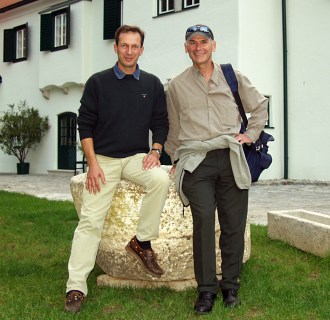 |
|
|
| Steinfeder is the simplest. The name comes from a grass that grows in
the rocks among the vines and these are light wines, for drinking soon after
bottling. Next is Federspiel, named after a device used in falconry to lure the
hawk back to the glove and these wines need a year or two in bottle before
consumption. Finally we have Smaragd, which means both emerald, and an
emerald-colored lizard natural to the Wachau of which these wines need time and
will keep well. |
|
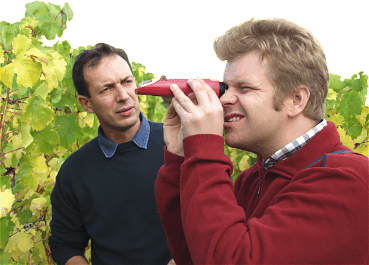 |
|
Rolf and I became even
more determined now to learn the secrets of finding the right time to harvest
the grapes. We were astonished by Mr. Bodenstein's knowledge of the terrain,
its chemical makeup and the influence it has on the quality of the wines.
His nick name in the region "The Terroirist" and there is no doubt about
his deep knowledge of the local geology while his skills in introducing us into
this complex matter were impressing, too. |
|
|
Before we knew it we were fast at the heals of Bodenstein as he sped
through the acres of vines while he did his work measuring the "Oechsle" level
of the grapes. This is the German method of measuring the specific gravity
(therefore sugar content), of the must or grape juice prior to harvest and
fermentation. It is similar to the brix system used in the United States.
Our education process now intensified as we were invited to visit the
cellars of the Prager Winery. Mr. Bodenstein allowed us to taste the different
stages of winemaking from the sweet grape juice to the bottled Rieslings and
Veltliners. Often referred to as the "jewel of the Wachau", Prager Winery is
one of the most recognized producers in the region and has become renowned for
noble Rieslings that reflect finesse, delicacy and excellent distinction.
|
|
It is the aim of this
winemaker and others in the region, to ensure that all grapes used in their
production come from recognized vineyards in the Wachau and each wine receive
approval from the local Vinea Wachau Nobilis Districtus a sort of quality
control board for Austrian winemakers.
Modern equipment with long
family tradition enables The Prager Winery to produce the best wine that the
weather and ground conditions allow year after year. While collaborating with
the near by university, Bodenstein exchanges his experience with the
crème de la crème of wine producers and rating specialists. He
has nothing to hide and so much to offer as we have happily found out.
|
|
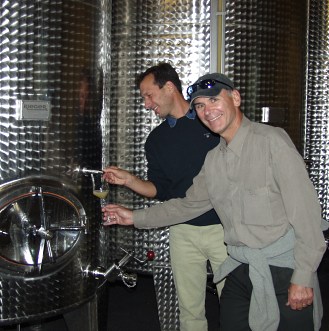 |
|
|
| Just take your time when being in the Wachau and consider visiting
this outstanding winery to relax with a glass of one of the finest Rieslings we
have experienced so far. |
|
THE PRAGER WINELIST
RIESLING
- FEDERSPIEL 2002 Ried
Steinriegl
- SMARAGD 2002 Ried
Hollerin
- SMARAGD 2002 Ried
Steinriegl
- SMARAGD 2002 Ried
Kaiserberg
- SMARAGD 2002 Ried
Achleiten
- SMARAGD 2002 Ried
Klaus
- SMARAGD 2002
Wachstum Bodenstein
|
|
VELTLINER
- FEDERSPIEL 2002 Ried
Hinter der Burg
- SMARAGD 2002 Ried
Weitenberg
- SMARAGD 2002 Ried
Achleiten
- SMARAGD 2002 Ried
Zwerithaler
- SMARAGD 2002 Ried
Achleiten
|
RARITIES
- Gr. Veltliner
Beerenauslese 1998 0,5l
|
|
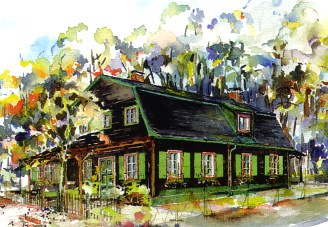 |
|
| The Steierstöck |
|
| Vienna - Austria |
|
 |
|
Society
September - 2003 |
|
5
Stars & 5 Stripes
Overall - 'Cuisine & Service' |
|
 |
|
The
Ultimate Award:
Seven Stars and
Stripes® |
|
|
|
| "Eine gemütliche Gaststätte" (a charming eatery) the
concierge at the Grand Hotel Wien said when I asked if he had ever heard of the
Wirtshaus Steirerstöckl. As I started up the V-10 TDI Volkswagen Phaeton
and punched in the restaurant's address into the GPS, I again felt reassured
when the doorman wished us a "Guten Appetit" and reminded me to save room for
dessert. What struck me as strange was that in a matter of a few minutes two
people in this world class hotel had spoken so highly of this 'Wirtshaus',
which is located within 15 minutes of the city center and offers "A little bit
of country in the city" as a recently published NY Times article had
stated. |
|
As I drove up one of the
many streets that radiate out from the center of Vienna, I began to see the
character of the area changing from Imperial cityscape to gently rolling hills
marking the start of the famous Vienna woods in which I will soon reach my
destination.
Steirerstöckl is well known for its authentic
regional cuisine coming from the Austrian province of Styermark and by the
looks of the multitude of cars parked all over, the Viennese population has
discovered its bountiful pleasures as well. The construction of the restaurant
is rustic in keeping with the traditional cute cottage-like wayside structures
that dot the countryside of provincial Styermark just waiting to offer up great
cuisine in a warm chalet atmosphere. |
|
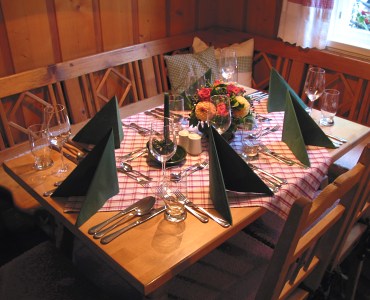 |
|
|
Upon entering the front doors decorated with the
fruits of autumn's bountiful harvest I was greeted warmly by a friendly smiling
waiter as if I was invited to his home for a family dinner. I was shown to a
table and even though the place was a buzz with animated patrons conversing in
their sing-song Viennese dialect, our host still managed to exchange reassuring
small talk to make me, a single diner, feel completely at home.
The
Goach family, owners and operators of this restaurant and its companion
Wirtshaus Jagawirt in Reinischkogel, Weststeiermark pride themselves on being
able to offer exceptional regional cuisine, using local produce and meats in
this especially well run and homey atmosphere. |
|
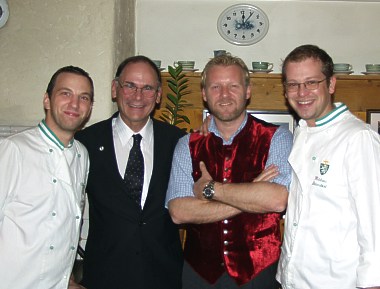 |
|
I decided that I would
first read the menu carefully to get a feel for what traditional
'Steirerisches' cuisine has to offer and then ask the chef to use his
imagination to put together his own version of a fabulous dinner from start to
finish complete with wine parings for each course. I was delighted to be
offered a glass of 'Schilchersturm' as an aperitif as I had heard that it is
most sought after by wine enthusiasts all over Austria at this time of year.
|
|
|
| An adorable rose petal pink liquid arrived with a very
fruity nose and a hint of raspberries; this is the fruit juice from red grapes
gone over just slightly to almost wine. Next, I was introduced to Executive
Chef Dieter Skrobanek who earnestly took the time to explain what was in store
for us from a culinary standpoint. |
|
I could now see how all
the creative pieces began to fall into place as the first course arrived
introduced by the delicate earthy aroma of fresh wild chanterelle mushrooms.
This first course was served over the pungent flavor of arugula and topped with
the perfect foil of sharp grana cheese and balsamic vinaigrette dressing.
The conscientious waiter seamlessly placed a glass of 'Gelber Muskateller
'02', Riegelnegg Vineyards Südsteiermark next to my special starter.
|
|
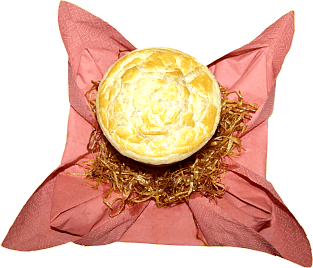 |
|
|
| I noticed a deep golden hue wafting big fruit and a
dry finish with suggestions of apple blossom and rosebuds. So far so good I
thought as I made a mental note to applaud the creative efforts of Chef Dieter
and his capable crew, when the next course arrived. This time a consommé
of black truffles baked in a crock covered by a puff pastry shell paired with a
'Sauvignon blanc '02', Sabathi Vineyards of Südsteiermark. Both were
delightfully light and refreshing, a definite prelude of things to
come. |
|
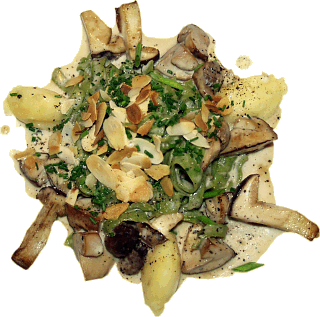 |
|
Just when it occurred to
me that I had finished two courses of which both contained wild mushrooms of
various preparations, along came the third course of homemade spinach noodles,
truffle filled potato croquets and you guessed it, more mushrooms!!
This time porcinis were added to the puree and topped with toasted almond
slivers to provide depth and structure and quite honestly it tasted heavenly
when paired with a 'Welschriesling '02', from the Scheucher Vineyards of
Südsteiermark, a typically medium dry fruity rendition of the famous grape
varietal. |
|
|
| Now, after a pleasant
pause to enjoy the lively atmosphere of staccato laughter and the warmth of the
glowing fireplace, it was time for the fourth course to be presented: Homemade
sheep cheese raviolis in a light curry sauce drizzled with aromatic pumpkin
oil, roasted wild onions and garden fresh tatsoy. |
|
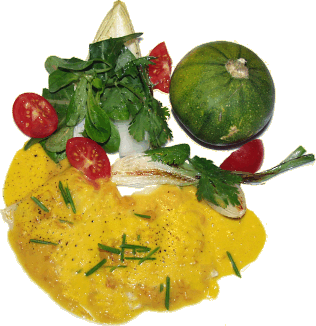 |
|
|
| I
had to keep reminding myself that there was more to come so I came to
appreciate the delicate portions and lightness of the sauces while I prepared
to take on the main course. The waiter placed a glass of CMB '02 (cabernet
sauvignon, merlot, blaufrankirch) in front of me, by Rosi Schuster Vineyards of
Burgenland, another of the great-undiscovered wine growing regions of Austria.
While savoring the first sip I reflected on the deep purple plum color and the
exciting morello cherry nose, it reminded me of an ample merlot with the
youthfulness of a pinot noir and the slight tannin finish of a California
cabernet. |
|
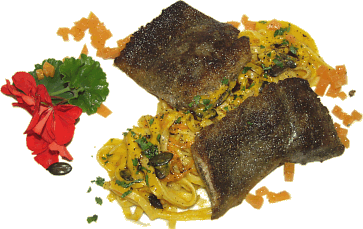 |
|
The anticipation
heightened as I relished the aftertaste of the CMB '02, when suddenly Chef
Dieter himself arrived bursting with pleasure as he placed his unique creation
on the table for visual dissection. Pan seared mountain stream trout filet
caught in the glacially fed rivulets in the hinterlands of Steiermark, placed
on top of fresh made pumpkin noodles with chopped fresh cooked pumpkin cubes
and roasted pumpkin seeds.
The obvious health benefits of pumpkin
aside, I truly enjoyed and savored every morsel and decided that I would have
to bring a bottle of the locally produced pumpkin oil home to New York to be
sparingly doled out on special occasions amongst friends and
family. |
|
|
I
was now ready to call it a day but not so fast as I was quick to remember the
prophecy of the doorman at the Grand Hotel Wien, 'Save room for desert', and at
this time it had to come true. After a thorough clearing of the dinnerware and
the crumbing of the table, I caught a sheepish glance from the waiter to sort
of get a feel if I was in the mood to continue, and of course the answer was
YES!
So far I felt the presence of steady imagination at work in the
kitchen, carefully constructing each course while first building a foundation
in the early stages, then adding height and depth through the use of locally
grown produce and excellent selections of wines, and culminating with the
gentle tease of sweetness to cap off the entire special event. |
|
I wasn't disappointed
when the pastry chef announced the arrival of a poppy seed soufflé
decorated with fresh picked raspberries and blackberries, tenderly caressed by
a sabayon made with the very fresh raspberry scented 'Schilchersturm' that was
presented to us as an aperitif at the start.
To compliment this
seductive statement was the dessert wine Ruster Ausbruch '98 from
Feiler-Artinger Vineyards Burgenland, which is produced using the
Welschriesling and Weissburgunder varietals. |
|
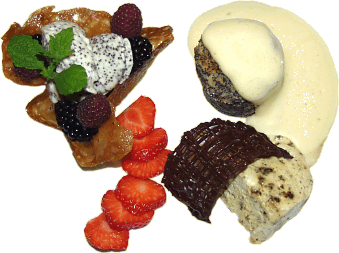 |
|
|
| I
don't really know how to thank Peter Goach and his family for this crash course
in regional Steiermark cuisine, but we must say that those who will venture
forth to the foothills of the Vienna woods will always covet within themselves
the glowing ember of this exciting and fulfilling discovery. Although quite
past my usual bedtime, I posed for some friendly photos and made each other a
promise to meet again someday at Steirerstöckl to celebrate our common
love for outstanding comfort food. Happy Trails! and 'Mahlzeit'! |
|
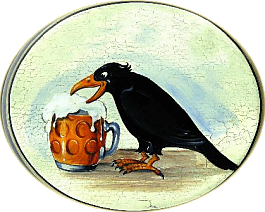 |
|
After a great Vienna
review Rolf and I decided to have a late night glass of Austrian tradition, a
delicious
Rabenbraeu
beer in the picturesque old bar named 'Schwarzer Rabe' located at the
Ottakringerstrasse 180 in the heart of the old town. Ask the young owners of
this Microbrewery when their next fresh brew will be ready. Cheers! |
|
|
| Take your time here especially when the weather doesn't cooperate
with your expectations. Try out the nice variety of microbrews and discuss with
the locals the elements that lift Rabenbraeu to the level of beers that we are
used to from German and Belgium local family brewers. |
|
|
|
|
Rolf Stähler & John Lomitola
Editor-in-Chief: Ingrid Lemme
|
|
| © 2003 ~ Seven Stars and Stripes, Inc. |
|
